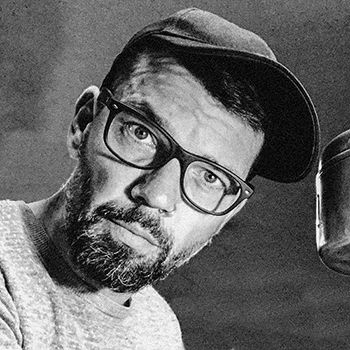Leffe Goldstein is a Graphic Artist living and working in Utrecht the Netherlands for over 25 years
Intrigued by places that were once full of life and loved by their inhabitants and builders, Leffe’s drawings are based on real, existing places or objects. Architecture, pieces of machinery, planes, helicopters and vehicles that were left to decay; objects that were invented and served a purpose, built with the hands of real people. In Leffe’s universe, these people are no longer there and long forgotten. But take a good look and you can see their demons are still thriving, breeding an alternative future world.
“Most people see demons as their wildest fears while others seem to enjoy them but the lucky ones have both.” Leffe Goldstein always starts sketching with pencil but the finished black and white works are drawn digitally. He uses the sketch as an under-layer and works endlessly on details to bring the demons to life. When finished the drawings are printed as a silkscreen print, or a Giclée.

What is a Giclée print?
Giclée (/ʒiːˈkleɪ/ zhee-KLAY) is a neologism, ultimately derived from the French word gicleur, coined in 1991 by printmaker Jack Duganne for fine art digital prints made using inkjet printers. The name was originally applied to fine art prints created on a modified Iris printer in a process invented in the late 1980s. It has since been used widely to mean any fine-art printing, usually archival, printed by inkjet. It is often used by artists, galleries, and print shops for their high quality printing. (Source: Wikipedia)What is a Silkscreen print, Screen printing is a printing technique where a mesh is used to transfer ink (or dye) onto a substrate, except in areas made impermeable to the ink by a blocking stencil. A blade or squeegee is moved across the screen to fill the open mesh apertures with ink, and a reverse stroke then causes the screen to touch the substrate momentarily along a line of contact. This causes the ink to wet the substrate and be pulled out of the mesh apertures as the screen springs back after the blade has passed. One colour is printed at a time, so several screens can be used to produce a multi-coloured image or design.
Traditionally, silk was used in the process. Currently, synthetic threads are commonly used in the screen printing process. The most popular mesh in general use is made of polyester. There are special-use mesh materials of nylon and stainless steel available to the screen-printer. There are also different types of mesh size which will determine the outcome and look of the finished design on the material.
The technique is used not only for garment printing but for printing on many other substances, including decals, clock and watch faces, balloons, and many other products. Advanced uses include laying down conductors and resistors in multi-layer circuits using thin ceramic layers as the substrate.